Mark M Upp has just been fired as the university bookstore m
Solution
I\'ll assume here that Mark only cares abuout the expected value of
his project and doesn\'t mind risk considerations. In order to answer
this question, we must then compute the expected value of all possible
alternatives. Let\'sa go through them one by one.
- Mark doesn\'t use the study
In this case, the probability of high demand is 0.5. Therefore,
Expected value of opening at:
Small site: 0.5*50000 + 0.5*(-10000) = $20,000
Large site: 0.5*80000 + 0.5*(-30000) = $25,000
So clearly, if Mark doesn\'t use the study, then he must choose to open
the large site, because of the greater expected value of it.
- Mark uses the study, and he gets a \"favorable\" one.
In this case, the probability of high demand is 0.8. Therefore,
Expected value of opening at:
Small site: 0.8*50000 + 0.2*(-10000) = $38,000
Large site: 0.8*80000 + 0.2*(-30000) = $58,000
Again, in this case, Mark should build the large site. Finally, the
last case would be
- Mark uses the study and he gets an \"unfavorable\" one.
In this case, the probability of high demand is 0.2. Therefore,
Expected value of opening at:
Small site: 0.2*50000 + 0.8*(-10000) = $2,000
Large site: 0.2*80000 + 0.8*(-30000) = -$8,000
Now, we know that there is a 60% chance that the study will be
favorable. We also know that if the study is favorable, Mark will
build the large site (EV: $58,000) and if he the study is not
favorable, he will do nothing (EV: $0). Therefore, the expected value
of performing the study is:
EV of study: 0.6*58000 + 0.4*0 = $34,800
Finally, in order to determine wether to use the study or not, we must
compare the EV of using the study and the EV of not using it. We
concluded that if he didn\'t use the study, he would build the large
site, for an expected value of $25,000. We\'ve also seen that the
expected value of the study is $34,800. Therefore, since the latter is
greater, he must choose to do the study.
1b) As you can see in the previous equation, if the study were free of
charge, the expected value of using it would have been $34,800,
compared to $25,000 of not using it. This tells us that Mark should be
willing to pay up to (34800-25000)=$9,800 for the study. Let\'s see
why. If the study costs a bit more (say, $9,801), the EV of the study
becomes $24,999, which is less than $25,000, so he shouldn\'t use the
study; and obviously he shouldn\'t use it if it is even more expensive.
If the study costs a bit less (say, $9,799), then the EV of the study
becomes $25,001, which is greater than $25,000 so he should use it;
and clearly he should use it if it were cheaper than that. So the
limit is at $9,800. In general, one should be willing to pay up to the
excess expect value of using a study over the expected value of not
using it.


 Homework Sourse
Homework Sourse